Key Points
- Consider risk/reward of replant maturity group decisions. We submit that shorter relative maturities are necessary for late-season soybean replant decisions for soybeans to reach physiological maturity (R7) prior to a killing frost (30F).
- In years like 2023 with a late fall freeze, the reward of planting a later maturity group was realized; however, the risk of an earlier or average fall killing frost has a greater yield penalty when planting longer-season maturity groups vs. shorter season ones in late-season replant situations.
Replant decisions from June and July hailstorms to soybean can be stressful for all involved. Producers often ask what relative maturity to replant. In a previous article, we shared considerations when hail damaged soybeans throughout the state in July 2023. Shortly after this hail event, we recommended earlier maturity groups (1.5-2.0) using the SoySim model than what was being recommended by our industry partners (3.0-3.5), due to the long-term average fall frost date.
We mention 30°F for a killing frost because a 32°F air temp does not take into account that plant tissue cytoplasm has solutes in it that depresses its own freezing point by a degree or two. Moreover, the air temperature near the bottom of the canopy is warmer than the two-meter-high air temperature reported by weather and TV stations.
In 2023, the authors followed five replanted soybean fields in the Waco, Nebraska area to determine the outcome to aid producers, crop insurance, and ag industry professionals in future decision-making. We hope this information is helpful to all in finding consensus on how to look at relative maturities in replant soybean decision-making.
What We Found
Five producer fields were followed from July 21-26 planting through harvest in 2023. Relative maturities ranged from Group 1.6-2.7. Some of the producers split the old rows, while most drilled the replant soybeans and all replanted at higher seeding rates (greater than 150,000 seeds/acre). Field information is found in Table 1.
| Field | Replant Date | Relative Maturity | Row Spacing | Harvest Date | Final Yield (bu/ac) |
|---|---|---|---|---|---|
| Field 1 (non-irrigated) | July 25 | 1.6 | 15” | 11/1-2/23 11/10-11/23 |
25 13 |
| Field 2 (irrigated) | July 25 | 1.6 | 15” | 11/3/23 | 18 |
| Field 3 (irrigated) | July 21-23 | 2.0 | 10” splitting 30” original |
unknown | 39 irrig. 10 non-irrig. |
| Field 4 (irrigated) | July 21-23 | 2.0 | Drilled 10” | unknown | 39 irrig. 10 non-irrig. |
| Field 5 (irrigated) | July 25 | 2.7 | Drilled 10” | unknown | 25 |
Ten consecutive plants were removed in the first 20 feet of row that was counted for soybean populations. The number of pods, nodes, average height from the soil line, and average distance from the soil line to the unifoliate leaves was measured, with averages shown in Table 2.
We also noticed that the lowest pods occurred on the cotyledonary nodes in Fields 2, 3 and 4. We collected this data as we sometimes receive questions on how low pod height occurs in replant soybean. The SoySim model predicted the stem node number fairly accurately with what was observed in the fields. Figures 1 and 2 show photos of field observations.
| Field | Avg. plants in 20’ of row | Avg. Nodes on 10 consecutive plants | SoySim Predicted Stem Nodes | Avg. Pods on 10 consecutive plants | Avg. Height (soil to top of plant) |
Avg. Distance from soil line to unifoliate |
|---|---|---|---|---|---|---|
| Field 1 (non-irrigated) | 87 | 11 | 12 | 25.3 | 11-12” | 3-3.5” |
| Field 2 (irrigated) | 95.5 | 9.9 | 12 | 19.9 | 11-14” | 2.5-3” |
| Field 3 (irrigated) | 54.5 | 11.9 | 12 | 24.6 | 16” | 3” |
| Field 4 (irrigated) | 39.5 | 12.7 | 12 | 40.6 | 16” | 2-2.5” |
| Field 5 (irrigated) | 52 | 13.3 | 13 | 36.7 | 17” | 2.5” |

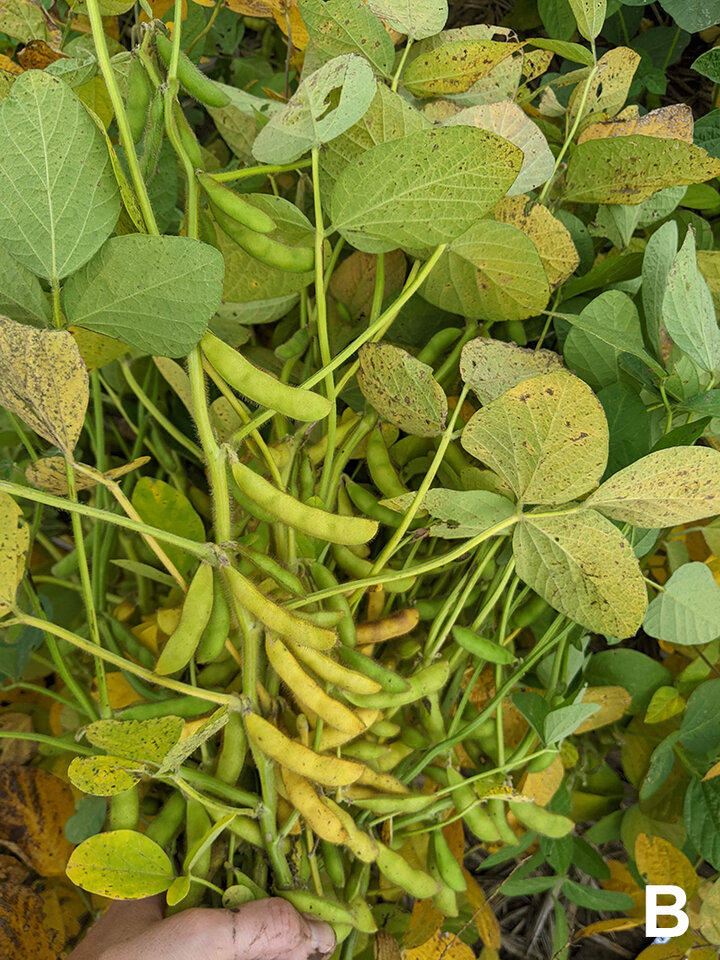

Figure 1A-C. (Click to expand) Data collected on Oct. 24, 2023: Counting plants in 20 feet of row (A), good pod development on these plants (B), opening a pod showed membrane separation from the seed had occurred resulting in at least R7 (C). (Photos by Jenny Rees)
The SoySim model was run by Jim several times during the 2023 season, and the growers were informed on when to anticipate physiological maturity (data not shown here). The data collected was compared against the SoySim model (Table 3).
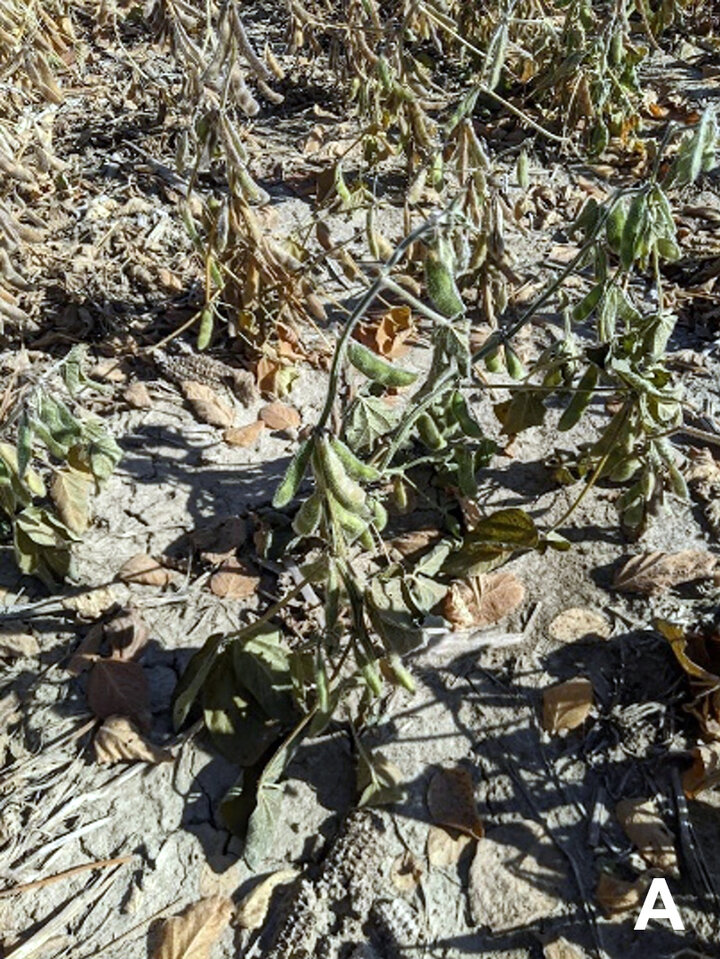

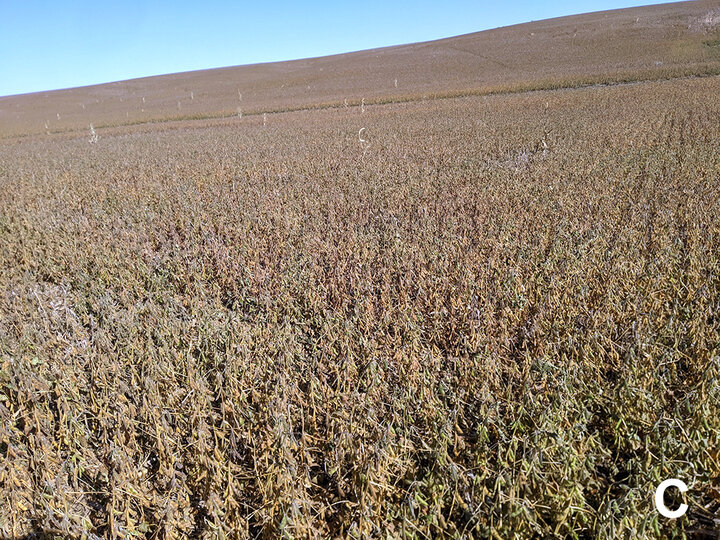

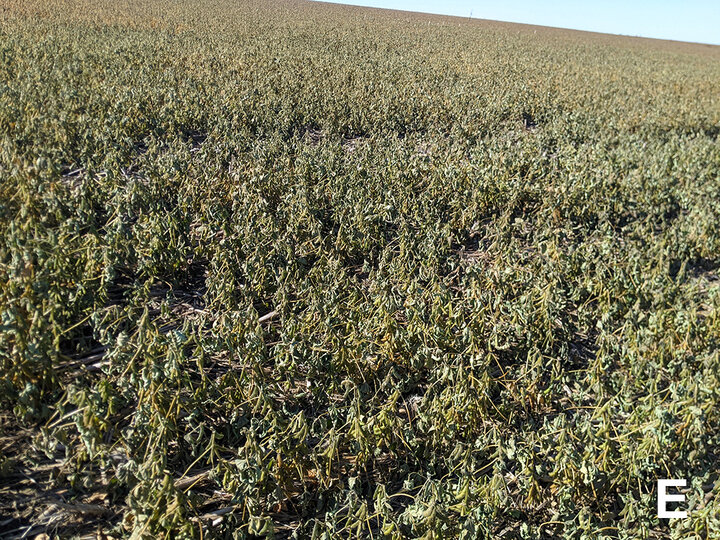
Figure 2. (Click to expand) Photos taken on Oct. 30, 2023 after the first killing frost on Oct. 27, 2023. Photos A and B are Fields 1 and 2. Photos C and D are of Fields 3 and 4. Photo E is of Field 5. Note that Field 5 did not reach physiological maturity (R7) prior to a killing frost, thus the green tint with leaves still on the stems. (Photos by Jenny Rees)
| Field | Planting Date | Relative Maturity Group | SoySim Predicted R7 Date | Actual R7 Date | SoySim Predicted Yield (bu/ac) | Actual Yield (bu/ac) |
|---|---|---|---|---|---|---|
| Field 1 (non-irrigated) | July 25 | 1.6 | 10/11/23 | *10/13/23 | 25-26 | 25 13 (later harvest) |
| Field 2 (irrigated) | July 25 | 1.6 | 10/11/23 | *10/13/23 | 25-26 | 18 |
| Field 3 (irrigated) | July 21-23 | 2.0 | 10/17/23 | *Before 10/24/23 | 31-32 | 39 irrig. 10 non-irrig. |
| Field 4 (irrigated) | July 21-23 | 2.0 | 10/17/23 | *Before 10/24/23 | 31-32 | 39 irrig. 10 non-irrig. |
| Field 5 (irrigated) | July 25 | 2.7 | 10/28/23 | *Pod separation occurred ¾ way up the plants on 10/25/23 | 31-32 | 25 |
*Note: Jenny wasn’t checking for R7 each day. The following denotes dates notes were taken and R7 was observed.
Risk vs. Reward
To help producers and ag industry professionals with replant decisions and which maturity group to choose, one should look at the risk of frost prior to reaching physiological maturity vs. reward of yield. Using the SoySim model with 13 years of weather data, Table 4 shows this risk/reward for maturity groups 1.5 to 3.5 planted on July 20. As can be seen, greater risk results when planting later maturity groups compared to the average first fall frost if they don’t reach physiological maturity prior to that frost. It’s important to not only look at the potential range of yields that can occur but also the median yield.
The first average fall frost date for York is around Oct.14. In 2022, the first fall frost occurred on Oct.7, impacting the tops of canopies, followed by an Oct. 14 freeze, which finished off plants in fields. In 2023, the first light frost of 32°F occurred on Oct. 7, followed by the first killing fall frost of 30°F on Oct. 27, 2023, far later than the average fall frost date. This allowed more time for the 2.0 to achieve R7 prior to the fall frost and the 2.7 to be closer to R7 prior to frost occurring.
Based on a July 20 planting date, planting a 2.0 maturity soybean provided the best reward for the risk. In the Waco, Nebraska area, Fields 3 and 4 were planted at a 2.0 maturity group around July 20 and the resulting yields were similar to what the SoySim model showed. Fields 1 and 2 were planted five days later, thus using a 1.7 maturity group was helpful in achieving physiological maturity and maximizing yield potential before average first fall frost. Field 5 had the greatest risk in planting a 2.7 maturity group on July 25. These soybeans had green leaves and stems, wilted and smelled like silage post-frost. However, the reward of a decent yield paid off in a late fall frost year like 2023.

| Maturity Group | Planting Date | Lowest Yield (bu/ac) | Highest Yield (bu/ac) | Median Yield (bu/ac) | Physiological Maturity Date |
|---|---|---|---|---|---|
| 1.5 | July 20 | 22 | 31 | 26 | Oct. 8 |
| 2 | July 20 | 23 | 35 | 30 | Oct. 16 |
| 2.5 | July 20 | 18 | 39 | 33 | Oct. 21 |
| 3 | July 20 | 15 | 41 | 32 | Oct. 29 |
| 3.5 | July 20 | 9 | 34 | 24 | Oct. 29 |
Note: A fall freeze before R7 may not necessarily reduce the above yield potentials but could result in “greenish” seeds causing potential dockage, the proportion of which will depend on the freeze timing before the R7 date (Figure 3).
*For reference, the 30-year average first freeze (30°F) in York is Oct. 14.
Conclusions
Each week after mid-July (July 15) rapidly changes the outcome of the relative maturity group options that will mature prior to any first fall freeze of 30°F.
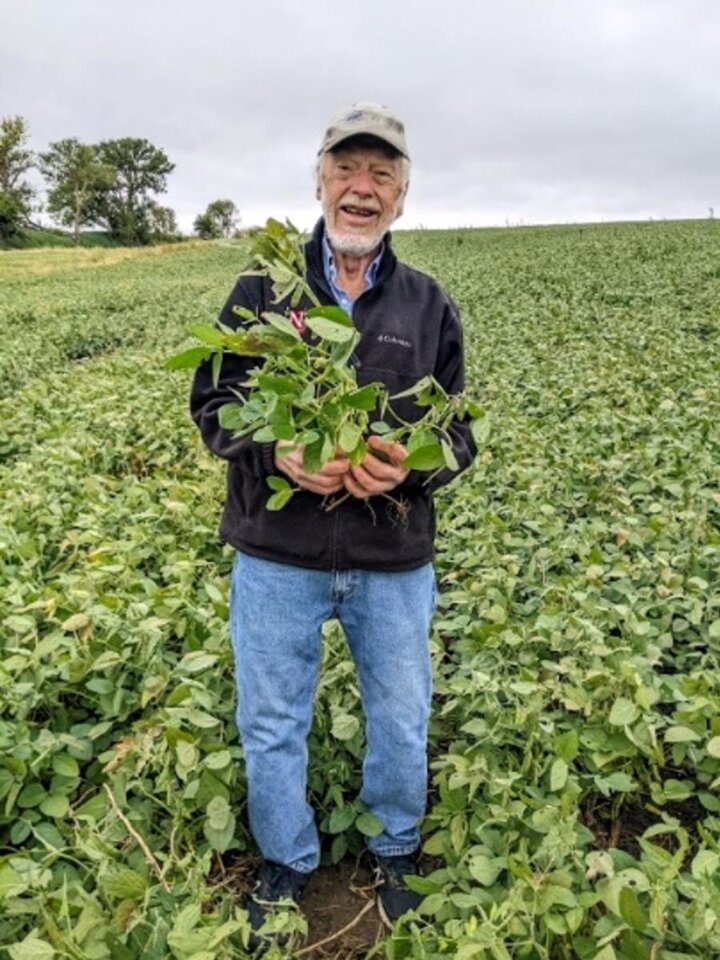
The SoySim model was a useful tool in helping growers better assess which relative maturity groups would achieve R7 (physiological maturity) prior to any first fall freeze. Frost that occurs during R6-R7 could result in green seeds being harvested (more if closer to or before R6).
Green soybeans will eventually shrink down and become more light green/yellow-green in color with time. If a dock is anticipated from the local elevator, storing the beans for a few months can help the beans achieve a lighter yellow-green color prior to selling.
Consider reward of yield vs. risk of reaching physiological maturity before a killing frost when making soybean replant maturity group decisions.
Resources
Center for Ag Profitability Webinar, June 2022, After the storm: managing crop damage. https://cropwatch.unl.edu/2022/after-storm-managing-crop-damage
Hail Know Team. June 10, 2022. Hail Damage Assessment Resources. https://cropwatch.unl.edu/2022/hail-damage-assessment-resources
Rees, Jenny, Jim Specht, Justin McMechan, Nicolas Cafaro La Menza, and Daren Redfearn. July 14, 2023. Hail damage to soybean in reproductive stages and options. https://cropwatch.unl.edu/2023/hail-damage-soybean-reproductive-stages-and-options
Rees, Jenny. June 20, 2022. Hail Damage Update. https://jenreesources.com/2022/06/20/hail-damage-update/
Soy Sim: https://soysim.unl.edu/
